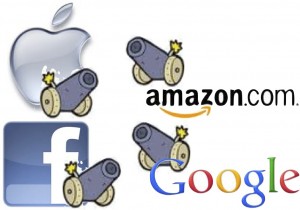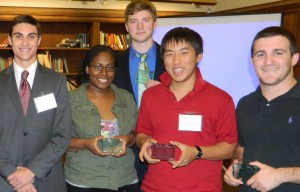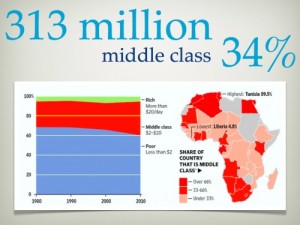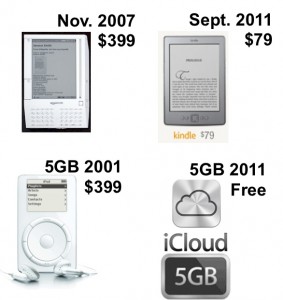
The Week in Geek™ – Oct. 31, 2011
The Great Tech War of 2012 The battle lines are forming for an all-out war among profitable, high-growth tech giants steeped in killer assets. The once clear lines dividing the businesses of Amazon, Apple, Facebook, and Google have blurred. Forces pushing the borders together include the redefinition of computing (in the cloud, in your pocket, and in your living room), media (always at hand and never delivered as ‘atoms’), and data (the prediction machine attached to a cash register that lives in the cloud). That cloud isn’t an ethereal, puffy wisp – it’s a ball and chain that bolts you to a firm the deeper you embed your life inside its technology. The digital locker is about digital lock-in. But it’s not as sinister as it sounds. The winner will be the firm that delivers the most compelling value proposition. The fact that there are many competitors along the new frontier means choice, competition, rapid innovation, and lower prices – all good news for consumers.
The battle lines are forming for an all-out war among profitable, high-growth tech giants steeped in killer assets. The once clear lines dividing the businesses of Amazon, Apple, Facebook, and Google have blurred. Forces pushing the borders together include the redefinition of computing (in the cloud, in your pocket, and in your living room), media (always at hand and never delivered as ‘atoms’), and data (the prediction machine attached to a cash register that lives in the cloud). That cloud isn’t an ethereal, puffy wisp – it’s a ball and chain that bolts you to a firm the deeper you embed your life inside its technology. The digital locker is about digital lock-in. But it’s not as sinister as it sounds. The winner will be the firm that delivers the most compelling value proposition. The fact that there are many competitors along the new frontier means choice, competition, rapid innovation, and lower prices – all good news for consumers.
These four horsemen of twenty first century consumer tech go toe to toe, or at least have begun to rub elbows, in all sorts of overlapping terrain. Consider that:
- All four firms now offer apps marketplaces where third parties enhance their ecosystems.
- All sell advertising and aggressively collect and leverage data to tailor offerings, services, and keep you tied to their clouds.
- All integrate with the post PC devices. All but Facebook sell them.
- All will recommend and sell you movies and TV programming.
- Music? They’re all there.
- Games? Ditto.
- Delivery and recommendation of news and magazines? Yup.
- All but Amazon have a videophone service. Put a lens on the Kindle Fire and Bezos’ll get there, too.
And they all want to tap into your wallet and perhaps someday be your bank. Earlier this year Apple announced iTunes has over 200 million accounts – making it the biggest credit card hub on the web. Amazon has 121 million customers. Facebook has turned its credits payment system into a nearly half-billion dollar a year business. And Google Wallet is the first of the big four with an NFC mobile payment platform. Purveyors of plastic cash, be worried. While the big four use credit cards today, it’s a simple tech trick to link directly to a customer’s bank account, cutting out fees consumers have learned to hate.
A quick look at the lineup offers eye-popping numbers:
 Apple currently jostles with Exxon-Mobile to be the most valuable firm in the world, but growth favors Cupertino. Exclude desktops and in every major category it competes in, Apple enjoys double-digit growth and margins, and it’s creating new categories. In less than a year the iPad sold enough product that if it were a stand-alone firm it’d land at about the mid-point of the Fortune 500. Some in the press yawned when the iPhone 4S was introduced, but Apple sold a record breaking four million units in the first three days, double the rate of any prior phone launch. It’ll earn an estimated $368 on each iPhone (they’re carrier-subsidized). Apple is by far the most profitable retailer in the US on sales/square foot basis, performing nearly 2x greater than #2, Tiffany. Apple defies the law of large numbers – the biggest is getting bigger faster than less profitable, smaller rivals. And the firm’s cash horde is an insanely-huge $81 billion. No dividends- this coin’s ready for battle.
Apple currently jostles with Exxon-Mobile to be the most valuable firm in the world, but growth favors Cupertino. Exclude desktops and in every major category it competes in, Apple enjoys double-digit growth and margins, and it’s creating new categories. In less than a year the iPad sold enough product that if it were a stand-alone firm it’d land at about the mid-point of the Fortune 500. Some in the press yawned when the iPhone 4S was introduced, but Apple sold a record breaking four million units in the first three days, double the rate of any prior phone launch. It’ll earn an estimated $368 on each iPhone (they’re carrier-subsidized). Apple is by far the most profitable retailer in the US on sales/square foot basis, performing nearly 2x greater than #2, Tiffany. Apple defies the law of large numbers – the biggest is getting bigger faster than less profitable, smaller rivals. And the firm’s cash horde is an insanely-huge $81 billion. No dividends- this coin’s ready for battle.- If user attention and data are arms in the new race, Facebook sits on an arsenal no-one can touch. More than one in ten world citizens has a Facebook account – astonishing when you think the world population includes China (that doesn’t have Facebook), babies, and others who aren’t realistically online. More than half these users visit each day. While Google has been built on indexing the public Internet, Facebook’s data cache is out of the reach of Larry & Sergey’s spiders. Facebook’s $4 billion+ in estimated revenue this year is tiny, but the firm hasn’t even begun to turn data value valve yet. It has no external advertising network (no “Ads by Facebook” to rival the “Ads by Google” you’ll find everywhere from the NY Times to smalltime blog sites). Facebook collects two billion “likes” a day – that taste making is ready to become a commerce engine. Reed Hastings of Netflix is now on Facebook’s board. Why not bake a Facebook platform into consumer electronics like Netflix did – a “like” button on the remote control? Of course, when that happens, who needs the networks, Netflix, Nielsen, or any other media middleman? Facebook can send you the stuff your friends, and its algorithms, say you’ll love.
- Google gushes cash. Its ad business has grown about 30 percent this year despite the global recession. And despite Microsoft’s constant attempts to chip at its edges, Google still holds down about a 65 percent share of search. Larry Page has shown great ambition since becoming CEO earlier this year. He’s launched Google+ (far behind Facebook, but with bragging rights as the fastest growing social network in history), he’s killed 28 laggard products, and this year Google has made 57 acquisitions so far this year. The biggest was buying Motorola Mobility. That makes Google a handset manufacturer (a risky bet), but it also puts Google on the set top of millions (look at your cable box – if it says Motorola, that’ll mean Google if the deal clears). The $12.5 billion for Motorola also brings in 17,000 patents – a potentially vital resource. Apple has shut down Samsung in Germany and Australia this year, and Cupertino may come knocking, claiming Android is a knock-off of the heavily patented iPhone. Patents give Google a counterpunch. And while the free Android only delivers about $10/user to Google (all in the form of increased mobile ad sales from increased usage), that’s adding up to a billion-dollar business – a vital opportunity should PC search advertising mature.

- Amazon threw down in September, offering up a quartet of Kindles from the $79 base model to the $199 color, video playing, web browsing 7” Kindle Fire. At half the price of the iPad it’s smaller and does less, but Amazon competes with a different playbook – it’s willing to take a loss on Kindle (estimated at between $10 and $50 per unit) to get it in the hands of millions. The reason is simple. For Amazon the Kindle isn’t just an eReader or media playing ‘post PC’ device. It’s the store. And Amazon cannot afford to give up the store since the store is the business. Amazon Prime, the firm’s $79 program offering unlimited two-day shipping, shows the impact of lubricating commerce. The year before a customer joins Prime they spend $400. This number jumps to $900 the first year in Prime. And Prime subscribers are growing at a 50% annual clip (students, remember you can get in on Prime for free). Prime subscribers also get to stream thousands of free television and movie titles (the firm paid CBS $100 million for 18 months streaming rights that include Star Trek). In another four years analysts think Amazon will hit $100 billion in revenue, passing the mark faster than any firm in history, and a full thirteen years faster than Wal-Mart’s pace. Amazon has bought up competitors that get to the edge of threatening it (Zappos, Diapers.com), and has done so thus far without justice department scrutiny. And it’s influence is way beyond retail and media. The Amazon cloud is the IS infrastructure for firms ranging from startups to Netflix (FastCompany claims that “even Apple relies in part on Amazon’s cloud infrastructure”).
As tech gets cheaper look for trends to continue. A couple of stats for our Moore’s Law fueled world – Amazon introduced the Kindle in 2007 at $399. Today it offers a base model at $79. Apple recently celebrated the 10th birthday of the original iPod, a $399 device with 5GB of storage. Today Apple’ll give you 5GB for free in iCloud. As we say in class, Moore’s Law means the impossible becomes possible and it leads to a new kind of price elasticity where whole new markets open up.
Why Software is Eating the World This article appeared in August and was recommended by many colleagues and former students but I’ve just gotten around to putting it in the WiG. It’s well worth the read! Marc Andreesen (the baldest guy at the right – click for interview video), current venture capitalist and the co-founder of two multi-billion dollar firms (Netscape and OpsWare/LoudCloud), writes in the Wall Street Journal that “every company I work with is absolutely starved for talent. Qualified software engineers, managers, marketers and salespeople in Silicon Valley can rack up dozens of high-paying, high-upside job offers any time they want, while national unemployment and underemployment is sky high. This problem is even worse than it looks because many workers in existing industries will be stranded on the wrong side of software-based disruption and may never be able to work in their fields again. There’s no way through this problem other than education, and we have a long way to go.” [note to those firms looking for a role-model program – at Boston College we’ve quadrupled the number of students studying technology & business in just four years].
This article appeared in August and was recommended by many colleagues and former students but I’ve just gotten around to putting it in the WiG. It’s well worth the read! Marc Andreesen (the baldest guy at the right – click for interview video), current venture capitalist and the co-founder of two multi-billion dollar firms (Netscape and OpsWare/LoudCloud), writes in the Wall Street Journal that “every company I work with is absolutely starved for talent. Qualified software engineers, managers, marketers and salespeople in Silicon Valley can rack up dozens of high-paying, high-upside job offers any time they want, while national unemployment and underemployment is sky high. This problem is even worse than it looks because many workers in existing industries will be stranded on the wrong side of software-based disruption and may never be able to work in their fields again. There’s no way through this problem other than education, and we have a long way to go.” [note to those firms looking for a role-model program – at Boston College we’ve quadrupled the number of students studying technology & business in just four years].
Geek up – the trends are clear. In a decade broadband access has grown from 50 million to roughly 2 billion people worldwide. In the next decade five billion people will own always-on pocket computers – smartphones. In a decade, we’ve seen the cost of hosting Internet applications fall by a factor of 100 thanks to the power of the cloud. Firms that failed to see how software-driven businesses enable fundamentally different cost structures and competitive assets have failed miserably – witness Borders and Blockbuster, among many others.
Music is now software with record labels existing only to provide “software companies with content… Music industry revenue from digital channels totaled $4.6 billion in 2010, growing to 29% of total revenue from 2% in 2004.” Pixar was a software company – Disney was forced to buy it to stay relevant in the world of animated movies.
The highly controversial Groupon, which uses software to power and distribute local coupons, generated over $700 million in revenue in 2010, after being in business for only two years.
The trends can swamp even technology firms. While video game revenues are have doubled to $60 billion in five years, traditional firms such as EA and Nintendo suffer, while new revolutionaries Zynga ($235 million in Q1 revenues this year), Angry Birds parent Rovio ($100 million in revenue this year), and Apple (maker of the largest game platform in the world despite not offering a conventinoal ‘gaming device’) have redefined game content, delivery, and consumption.
And as our students study, Wal-Mart, FedEx, the airline industry, biotech, and financial services are all built on a bed of modern software. Oil and gas exploration happens because of data visualization and supercomputer analysis. Satellite imagery and math power modern agriculture. And as we’ve seen with drones and other defense initiatives, the modern soldier is increasingly a robot.
Not only does the manager need to think strategically about technology, they also need to think deeply about broader implications – privacy, security, and the downside if this technology guesses wrong or funnels behavior and activities in narrowly defined ways. But that doesn’t mean we should use less of this or even stop it. It does mean that if we’re to use it properly, all of us need to learn more about the role technology plays in our current world. Ignore it and you ignore our future.
The Science Behind Viral Marketing We often talk about the value of viral marketing, but David Skok, a successful venture capitalist at Matrix Partners, gives the concept depth with this great slide deck (above), and accompanying post on “Understanding the Key Variables in Viral Marketing”. It’s a fantastic resource for anyone seeking to understand how to leverage virality to grow a business and potentially jumpstart network effects. We’ve been fortunate to have had David speak at a past Boston College Technology Council event, and he’s also scheduled to speak as part of a Boston College Venture Competition program. All are invited out to hear David talk on “Business Models 2.0: How the web is changing sales and marketing, and creating new business models”, at 6:30pm on Nov. 30th. Location TBA, but stay tuned at bcvc.org and follow @BostonCollegeVC on Twitter for details. Also – those in the Eagle Startup Tribe also likely want to hear BC alum John Prendergast, leader of Boston’s Lean Startup Circle, talk about Lean Startups on November 9. 7 p.m. (location TBA).
We often talk about the value of viral marketing, but David Skok, a successful venture capitalist at Matrix Partners, gives the concept depth with this great slide deck (above), and accompanying post on “Understanding the Key Variables in Viral Marketing”. It’s a fantastic resource for anyone seeking to understand how to leverage virality to grow a business and potentially jumpstart network effects. We’ve been fortunate to have had David speak at a past Boston College Technology Council event, and he’s also scheduled to speak as part of a Boston College Venture Competition program. All are invited out to hear David talk on “Business Models 2.0: How the web is changing sales and marketing, and creating new business models”, at 6:30pm on Nov. 30th. Location TBA, but stay tuned at bcvc.org and follow @BostonCollegeVC on Twitter for details. Also – those in the Eagle Startup Tribe also likely want to hear BC alum John Prendergast, leader of Boston’s Lean Startup Circle, talk about Lean Startups on November 9. 7 p.m. (location TBA).
Ready, Set, Pitch: A Recap of the BCVC Elevator Pitch Competition Speaking of BCVC – 36 teams entered this year’s Boston College Venture Competition Elevator Pitch Competition. Judges included Bijan Sabet (BC alum and Spark Capital investor in Twitter, Tumblr, Foursquare, and many others), Katie Rae (Managing Director of TechStars Boston), and Greg Dracon (Partner at .406 Ventures). This year saw the first-ever awarding of a BC SEED track prize for social entrepreneurship. The track record of prior BCVC EPC participants is pretty strong – last year’s teams went on to win the Mobile Track in the Exec Summary Competition of the MIT$100K, place as a finalist in Mass Challenge, and win a slot in Highland Capital Partner’s elite and highly competitive Summer@Highland program. Lauren Landry of BostInnovation covered the event. Want to participate or attend future BCVC events? See http://bcvc.org.
Speaking of BCVC – 36 teams entered this year’s Boston College Venture Competition Elevator Pitch Competition. Judges included Bijan Sabet (BC alum and Spark Capital investor in Twitter, Tumblr, Foursquare, and many others), Katie Rae (Managing Director of TechStars Boston), and Greg Dracon (Partner at .406 Ventures). This year saw the first-ever awarding of a BC SEED track prize for social entrepreneurship. The track record of prior BCVC EPC participants is pretty strong – last year’s teams went on to win the Mobile Track in the Exec Summary Competition of the MIT$100K, place as a finalist in Mass Challenge, and win a slot in Highland Capital Partner’s elite and highly competitive Summer@Highland program. Lauren Landry of BostInnovation covered the event. Want to participate or attend future BCVC events? See http://bcvc.org.
Africa: Turning the World Upside Down Many of you have written to say you’ve enjoyed the examples of “Tech for Good” that I’ve been including in recent “Week in Geek” postings. You may also enjoy this recap and overview of mobile technology in sub-Saharan Africa. Several locally-grown technologies are having wide and impactful use, including:
Many of you have written to say you’ve enjoyed the examples of “Tech for Good” that I’ve been including in recent “Week in Geek” postings. You may also enjoy this recap and overview of mobile technology in sub-Saharan Africa. Several locally-grown technologies are having wide and impactful use, including:
- M-Pesa, the text message payment service by Kenya’s Safaricom which supports about $1 billion a month in funds transfers.
- Ushahidi, a crowdsourcing visualization and mapping effort used for everything from exposing corruption to tracking issues in the aftermath of natural disaster. The platform now has over 20,000 deployments in 132 countries.
- Mxit, a South African mobile chat platform that has 3x the number of Facebook users in that country, and over 25 million users worldwide.
Also be sure to check out the great slide deck “Mobile Trends 2020 Africa” – chock full of stats, graphs, and lovely images.
Some Press
It’s always nice when our work gets attention. A few noteworthy items this past month include:
- Being named (along with my colleague Jerry Kane) to the BostInnovation list of “Top Boston-area Professors, Deans, and Presidents to Follow on Twitter”
- Quoted in the NY Time story “Apple’s Lower Prices Are All Part of the Plan”
- Quoted in the Boston Globe story “Investors in Startups Score Big Despite Slump”
Finally, like many of you, I was moved by the passing of Steve Jobs. I’d shared a personal reflection the next day and was honored to learn that a member of Apple’s AcademiX effort had shared it with the rest of their Education Team. It was simply a small way to honor not only the legacy of Steve Jobs, but also the hard working people at Apple who have created products that empower and inspire so many. We remain grateful for your work.

